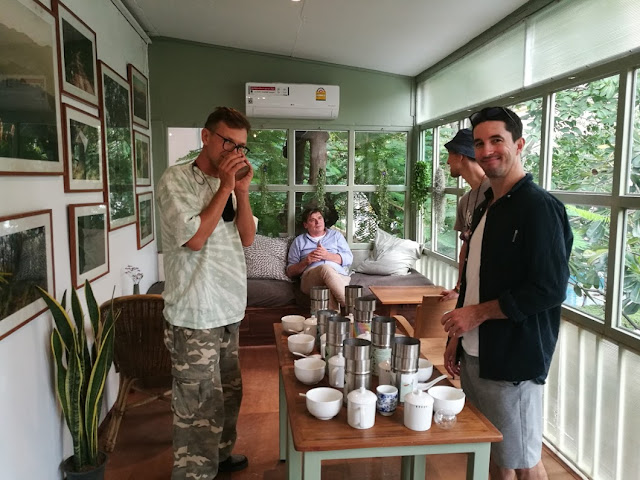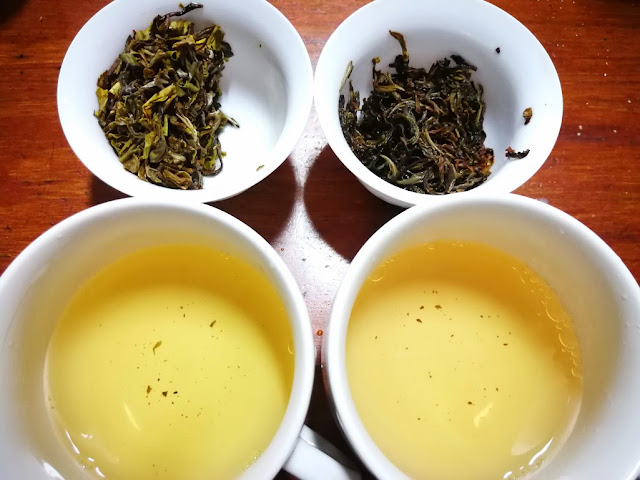 |
white left, black right |
 |
nice labels and packaging, simple branding; all good |
I've tried and reviewed some Ceylon here before but it's probably the main growing area that I get to least. I've tried lots more versions from places like Laos and Indonesia that aren't producers on that scale, without that same history. Indonesia does have a long colonial history of producing tea, so that's different, but Sri Lanka had always been one of the main top-5 producer nations.
Here's a list placing that better; those are always nice:
Kaley Tea background
Review:
 |
white left, black right, in all photos |
White: that is actually fairly subtle, but then this is just the first round. I'll probably need to use an offset timing for both, bumping this one a little and keeping the other quite moderate. Both I brewed for around 15 seconds this round, which may have this one too light and the other about right, just subtle for being the first round. It's interesting how a creamy fullness to the texture did come out but flavor range is limited. What I do taste is creamy in flavor, with nice sweetness, and a hint of something along the line of pine. I suppose the vague sweetness could be flagged as floral, since that's something of a default.
It'll be interesting to see how this develops. If intensity never does pick up this would probably need to be brewed on the strong side, to get flavor input to balance better.
Black: really interesting. That savory, sun-dried tomato aspect does stand out as primary, supported by a lot of warm mineral tone. This is really clean and intense in flavor for this not being brewed strong at all on this initial round. An astringency and dryness pairs with all that, moderate enough to work well, but unfamiliar now since I've been off better Assam and onto drinking Chinese black teas and Darjeelings this year. It's not really the feel that pairs with distinctive malt in Assam, but it's not that far from that either. Mineral is present instead of malt (with a touch of malt).
I remember a fellow favorite blogger saying that she didn't like Ceylon because it tasted like blood to her. I get why; a warm mineral range can be something that might not work for everyone. To me a pronounced mineral base is most often a sign the tea is of good quality, a marker for that, relating to older plant input or even to some degree of more-natural growth, versus forced rapid production through monoculture farming approach and use of chemicals to push yield. This doesn't exactly taste like blood to me but beyond the salt level being lower I suppose that partly works.
It all balances well enough. It's a bit early for a lot of discussion of that, the conclusions, but even early on the sweetness, flavor tone, feel, cleanness, and overall balance work. There's a touch of aftertaste that is a pleasant effect, tied to the heavy mineral and moderate dryness. It will be interesting to see how this evolves too, but for a different reason, to see how the balance shifts.
Second infusion:
I did use a 10 second timing on the black and out towards 20 on the white. Proportion probably isn't an exact match, higher for the black tea. It's like magic how I'm usually able to keep that incredibly consistent without weighing teas but eventually it would be off a little. I'm not accustomed to white buds not expanding much these days.
White: really rich and creamy. I tend to overuse that one term a little, mentioning it when any creaminess is present, but this is different. Then again I bet that aspect stands out more because the flavor is still so subtle. The flavor that is present is positive, warm in nature, with complexity but very low intensity. Someone who loves subtle white teas would be delighted by this. For people who tend to dislike them it probably just wouldn't work. Pushing it further by extending infusion strength, going up to 30 seconds, would draw out more intensity, but the effect only goes so far. Mineral tone (along with some added astringency) extracts more when you do that, versus some lighter range more towards vague floral. The floral is along the line of chrysanthemum; a bit non-distinct.
I actually like the tea, it's just not a personal favorite style. That complexity (within a narrow range) and sophisticated layering only comes up in beyond typical quality level versions. A little more sweetness would shift how the floral range is perceived, but it is what it is, positive in a different way.
Black: a lot of clove spice joined this flavor profile; that's different. That may be the most clove I've ever tasted in any non-flavored tea version. I love it, but then I love clove. This is brewed a little light, which for me is pretty close to optimum for what it is. That probably increases the clove flavor effect, with warm mineral and astringency (related dryness) standing out more at a higher infusion strength. It's such a cool effect that I want to say more about it but there's nothing more to add. The scaled back warm mineral works well as more of a base context, and clove really stands out. Sweetness, feel, and overall balance are good. Onto the next then.
Third infusion:
White: evolving, but within a narrow range. The neutral flavors now include more of a milky tone I would associate with young tree bark. I guess to put that in more familiar terms it's a bit like a mild root spice, like one part of root beer (sassafras). It's cool how thick and creamy that feel is, with some base context flavor, a mineral range, without much for higher range. I like it but there was definitely a time that I wouldn't have. Sheng that ages to fade to a thick, smooth feel that lacks a lot of forward flavor can be like this. At first the experience seems to be mainly that of a gap but once you can deal with the shifted expectations thick feel with more mild, somewhat floral flavor range can be pleasant.
Black: plenty of clove, with more bite to the clove this time, not just the aromatic sweet range from those, but also the sharper edge that joins that spice. Brewing it slightly stronger may have caused some of that.
I'm not quite as focused in as usual today, so I'd expect variation in brewing approach to come up more. The first thing I did this morning, after eating a bowl of breakfast cereal, was to go back to bed for another hour. A run took it out of me yesterday, and it was a sort of busy week at work (although it seems odd saying that for all that I ever get done). And all the noise of election news and political protest here adds up, with pandemic tracking a constant underlying theme. We have no pandemic here; I think we've had 3 or 4 cases of in-country transmission in something like 130 days, exceptions coming up that shouldn't, from causes like people crossing borders through uncontrolled locations. All the same I'm worried for people in the States and elsewhere, so I keep checking on it.
Fourth infusion:
This should work for final thoughts, even though I'd expect these to be about half finished. There may be some interesting late-round transitions, but this is enough tasting, writing, and tea consumption for right now.
White: if you strain to make it out some of the black tea character may come across in this, maybe even the clove, but especially that savory range. That may be why the overall impression is that of being complex even though flavor intensity is so limited. Whether that's true or not it does seem like the flavor is quite complex, just a bit muted. And a full, creamy feel makes up for that, adding depth, and then standing out as the primary thing you experience. It's interesting.
I did let the next infusion--the fifth, which I'll mention here--run a little longer, and the flavor and character seemed closer to a really mild black tea for that. It was interesting how sweetness increased along with flavor, and a hint of dryness started toward the mild astringency character in the other.
Black: mineral is really bumped up this round; that probably is tied to a timing shift. Just a bit lighter would be more pleasant, letting the spice stand out more. It's still nice though. It helps that astringency is so moderate in this that it comes across only as a dry edge, shifting the feel, but not as roughness, so there's no need to "brew around" it. This is about as much mineral tone as any tea usually has. For someone who feels like they don't get what that description even means they should try this version.
A next round is much better brewed lighter again. The clove is pulling way back, with some wood-tone filling in along with that and the spice and mineral, in the range of cured hardwood. It's still pleasant, just moving towards a brewed-out character. It should have a couple more really nice rounds in it before a transition seems a lot less pleasant.
Conclusions:
I'm not sure if a general quality level assessment came across as implied in all that. These are really good teas; nothing like this will probably ever turn up in a grocery store aisle, in any country. I've only checked on that in a dozen countries so far but it's a good sample. As far as how good this is in relation to how good Ceylon could possibly get, or how close they are to a type-typical near-best Ceylon example I'm not as clear. Reasonably far up the scale, I think; maybe not crowded towards the top. That probably means less for white teas, because those would probably be a less-typical category type to begin with.
The black tea seemed like really good Ceylon to me; there is that. That mineral range stands out, kind of the equivalent to a heavy malt tone in Assam for Ceylon being distinctive. From there refined character, lack of negative astringency, pleasant flavors, and overall balance all determine where the teas stand, per my limited understanding. To some extent it works to jump from evaluating teas as type-typical and just judge quality; to consider where these stand in relation to Chinese or Indian versions (or from Nepal, etc.). Preference for aspects that leads into preference for typical types complicates that.
This kind of theme came up in discussion with a vendor and blog author related to his claim that it's possible to do exactly that, to judge teas against an abstract quality level by a set of aspect categories: Structural Tasting And The Quest For Quality Tea, in a Tillerman Tea blog. I tend to agree with most of what that guy says, content-wise, and to partly disagree with every set of conclusions that he draws from those specific points. It's funny how that works out.
He says that you can evaluate Balance, Complexity, Mouthfeel, Length, and Persistence (what I tend to call aftertaste), and also Value, and together those peg how good a tea is. I would add "trueness to type" to that, but otherwise I'd just be quibbling over minor details and use of terms. In a sense adding that throws off what he's trying to say, because the idea is that you can evaluate any tea in an abstract and objective way, be it something completely novel (a tea you grew in your basement and processed on your own), or a standard type version. I guess that you could even run a tisane through the process, but he isn't really going there.
I should add that "Balance" draws on sweetness level quite a bit. Or maybe it's that there is an individual balance within how the flavor aspects hang together, and another over-all. He mentions something about that, "the bitterness and the sweetness work together." In retrospect that approach really does de-emphasize flavor being of primary importance, or even on par with other aspect range. Maybe it's just that no one really misses noticing how teas taste, and at one stage in form of appreciation flavor really is seen as secondary.
I think that understating a match to personal preference doesn't necessarily work. He's on a different sort of project there, trying to work out an objective quality level, but for a tea drinker that's kind of the natural end-point. As a blogger and reviewer it helps to use that as a yardstick, although it has to be clear when it is the form of measurement being applied, since that would vary by person.
Together trueness to type and match to preference define the experience, along with the rest. Of course sheng pu'er or oolongs are going to express completely different mouthfeel and aftertaste (or length) range than a Ceylon black tea. Using something closer to a scale of 1 to 10 per category approach drops out that it's not just about expectation, it's about sets of aspects working well together, which is what is informing personal preference. Preference for mineral effect makes or breaks one's take on this black tea, and openness to a very light flavor input, filled in by heavier mouthfeel, plays a comparable role in how this white tea will come across.
Based on this yardstick, it's natural to consider how I like both, judged against my preference for teas. I've already said that I liked the white but it's not in a main range, tied to this factor, for being so subtle. I love fruity and intense white teas best, like the ones Nepal produces, or Moonlight White (from Yunnan, typically). For black teas I like fruit range the best for flavor character, along with rich feel, limited astringency, and overall complexity. I'm essentially describing Dian Hong, Yunnan black, my favorite black tea type, but a good bit of that applies to a Lapsang Souchong that I reviewed recently. Feel for that tea was structured, complex, and refined, but maybe not as rich and heavy. Nepal and Darjeeling blacks can be sweet with plenty of fruit, and orthodox Assam covers lots of range these days too. I guess I'm saying that good Ceylon black is enjoyable but not an absolute personal favorite.
In a sense that's not fair, because if I try a really good Ceylon black every two or three years it's not enough to get my preference to "click over" to focus on that. I've drank a lot more of all of those other tea types. There's also a strange thing that happens where you can try a version that absolutely works perfectly for you, then the rest of the range makes a lot more sense, and the same tea that you tried only weeks ago can seem much better. I'm not sure what that's all about; some strange psychological twist. There's a pretty good chance that if I tried another dozen Ceylon versions on this level one would prompt that shift, and this tea would seem more on par with other past personal favorites, even if it doesn't quite get there.
It's my take that both these versions aren't giving up much for quality to other teas, although of course the continuum for that just keeps going. Using Tillerman's approach (not really his name, just the blog name) that could relate to another aspect range filling in a little better. Maybe, but the theory and models for appreciation only go so far, and in the end you just know how much you like a tea. I think it's helpful to think through some basis for interpretation, which is why I keep referring to those types of aspect categories.
I really did like these, and it seems like this description probably overkills how much, and in what form, or related to what limitations.





























